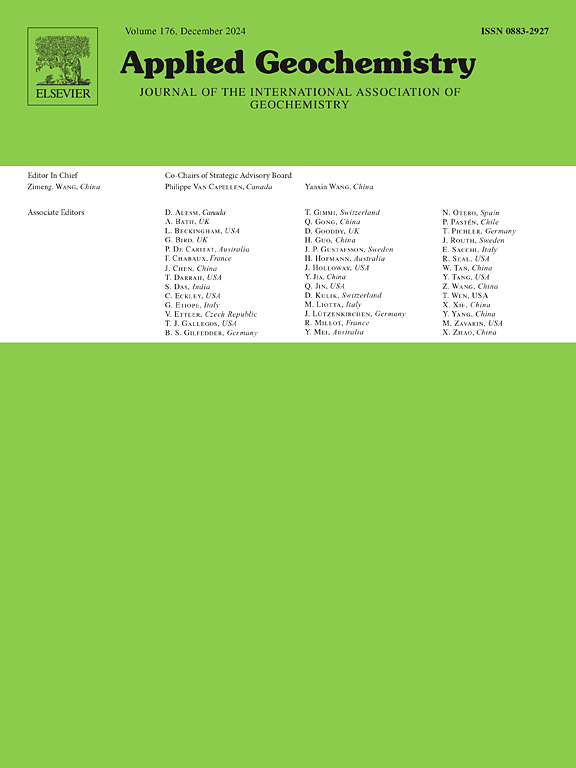Thermally-induced release of arsenic from minerals and phases relevant to polluted natural systems affected by wildfires
IF 3.1
3区 地球科学
Q1 GEOCHEMISTRY & GEOPHYSICS
引用次数: 0
Abstract
Fire-induced arsenic (As) emission from contaminated biomass or soil is dependent on its solid-phase speciation. To quantify the nature of this release, environmentally relevant As-bearing compounds (sulfides, sulfosalts, As-oxides, arsenates, As-doped Fe-oxyhydroxides and organic material) were experimentally heated with a linear temperature increase (25–800 °C) and simultaneous detection of As and other emitted elements. Organic As-bearing materials (fungi, dimethylarsinic acid-DMAA) exhibited the peak of As release at the lowest temperatures of 275–350 °C, followed by arsenolite (As2O3) with the maximum As emission at ∼400 °C. Realgar (As4S4) and orpiment (As2S3) exhibited the maximum As release at 425–450 °C, while enargite (Cu3AsS4) and arsenopyrite (FeAsS) released As at much higher temperatures with emission peaks at ∼625 and > 725 °C, respectively. Similarly, As-bearing Fe-oxyhydroxides emitted As at temperatures exceeding 650 °C. Arsenic emission from arsenates was rather variable and peaked at ∼700 °C for conichalcite [CaCu(AsO4)(OH)], and scorodite (FeAsO4·2H2O), while for mimetite [Pb5(AsO4)3Cl], it peaked towards the upper limit of the temperature range. These results suggest that typical low intensity wildland fires would affect only organically bound As and arsenolite, while higher intensity wildland fires could cause the redistribution of As from all studied phases, thereby posing a significant environmental risk of As redistribution beyond contaminated sites.

与受野火影响的受污染的自然系统有关的矿物和相中热诱导的砷释放
火灾引起的砷(As)排放从污染的生物质或土壤是依赖于其固相形态。为了量化这种释放的性质,对与环境相关的含砷化合物(硫化物、硫盐、砷氧化物、砷酸盐、砷掺杂铁氧氢氧化物和有机材料)进行了实验加热,线性升温(25-800℃),同时检测As和其他释放元素。有机含砷材料(真菌、二甲基胂酸- dmaa)在275 ~ 350℃的最低温度下释放出最大的砷,其次是砷砂(As2O3),在~ 400℃时释放出最大的砷。雄黄(As4S4)和黄芪(As2S3)在425-450°C时释放出最大的砷,而辉石矿(Cu3AsS4)和毒砂(FeAsS)在更高的温度下释放出砷,其峰值在~ 625和>;分别为725℃。同样,含砷的铁氧氢氧化物在温度超过650℃时释放出砷。砷酸盐的砷排放变化很大,锥方石[CaCu(AsO4)(OH)]和铁长石(FeAsO4·2H2O)在~ 700℃达到峰值,而镁铁石[Pb5(AsO4)3Cl]则在温度范围的上限处达到峰值。这些结果表明,典型的低强度野火只会影响有机结合的砷和亚砷砂,而高强度野火可能会导致砷从所有研究阶段重新分布,从而对污染地点以外的砷重新分布造成重大的环境风险。
本文章由计算机程序翻译,如有差异,请以英文原文为准。
求助全文
约1分钟内获得全文
求助全文
来源期刊

Applied Geochemistry
地学-地球化学与地球物理
CiteScore
6.10
自引率
8.80%
发文量
272
审稿时长
65 days
期刊介绍:
Applied Geochemistry is an international journal devoted to publication of original research papers, rapid research communications and selected review papers in geochemistry and urban geochemistry which have some practical application to an aspect of human endeavour, such as the preservation of the environment, health, waste disposal and the search for resources. Papers on applications of inorganic, organic and isotope geochemistry and geochemical processes are therefore welcome provided they meet the main criterion. Spatial and temporal monitoring case studies are only of interest to our international readership if they present new ideas of broad application.
Topics covered include: (1) Environmental geochemistry (including natural and anthropogenic aspects, and protection and remediation strategies); (2) Hydrogeochemistry (surface and groundwater); (3) Medical (urban) geochemistry; (4) The search for energy resources (in particular unconventional oil and gas or emerging metal resources); (5) Energy exploitation (in particular geothermal energy and CCS); (6) Upgrading of energy and mineral resources where there is a direct geochemical application; and (7) Waste disposal, including nuclear waste disposal.
 求助内容:
求助内容: 应助结果提醒方式:
应助结果提醒方式:


